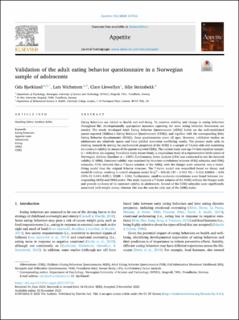| dc.contributor.author | Bjørklund, Oda Katrine Nilsen | |
| dc.contributor.author | Wichstrøm, Lars | |
| dc.contributor.author | Llewellyn, Clare | |
| dc.contributor.author | Steinsbekk, Silje | |
| dc.date.accessioned | 2024-02-22T12:32:18Z | |
| dc.date.available | 2024-02-22T12:32:18Z | |
| dc.date.created | 2024-01-26T08:23:06Z | |
| dc.date.issued | 2024 | |
| dc.identifier.citation | Appetite. 2024, 192 . | en_US |
| dc.identifier.issn | 0195-6663 | |
| dc.identifier.uri | https://hdl.handle.net/11250/3119365 | |
| dc.description.abstract | Eating behaviors are related to health and well-being. To examine stability and change in eating behaviors throughout life, developmentally appropriate measures capturing the same eating behavior dimensions are needed. The newly developed Adult Eating Behavior Questionnaire (AEBQ) builds on the well-established parent-reported Children's Eating Behavior Questionnaire (CEBQ), and together with the corresponding Baby Eating Behavior Questionnaire (BEBQ), these questionnaires cover all ages. However, validation studies on adolescents are relatively sparse and have yielded somewhat conflicting results. The present study adds to existing research by testing the psychometric properties of the AEBQ in a sample of 14-year-olds and examining its construct validity by means of the parent-reported CEBQ. The current study uses age 14 data (analysis sample: n = 636) from the ongoing Trondheim Early Secure Study, a longitudinal study of a representative birth cohort of Norwegian children (baseline: n = 1007). Confirmatory factor analysis (CFA) was conducted to test the factorial validity of AEBQ. Construct validity was examined by bivariate correlations between AEBQ subscales and CEBQ subscales. CFAs revealed that a 7-factor solution of the AEBQ, with the Hunger scale removed, was a better-fitting model than the original 8-factor structure. The 7-factor model was respecified based on theory and model fit indices, resulting in overall adequate model fit (χ2 = 896.86; CFI = 0.924; TLI = 0.912; RMSEA = 0.05 (90% CI: 0.043, 0.051); SRMR = 0.06). Furthermore, small-to-moderate correlations were found between corresponding AEBQ and CEBQ scales. This study supports a 7-factor solution of the AEBQ without the Hunger scale and provide evidence of its construct validity in adolescents. Several of the CEBQ subscales were significantly associated with weight status, whereas this was the case for only one of the AEBQ scales. | en_US |
| dc.language.iso | eng | en_US |
| dc.publisher | Elsevier | en_US |
| dc.rights | Navngivelse 4.0 Internasjonal | * |
| dc.rights.uri | http://creativecommons.org/licenses/by/4.0/deed.no | * |
| dc.title | Validation of the adult eating behavior questionnaire in a Norwegian sample of adolescents | en_US |
| dc.title.alternative | Validation of the adult eating behavior questionnaire in a Norwegian sample of adolescents | en_US |
| dc.type | Peer reviewed | en_US |
| dc.type | Journal article | en_US |
| dc.description.version | publishedVersion | en_US |
| dc.source.pagenumber | 0 | en_US |
| dc.source.volume | 192 | en_US |
| dc.source.journal | Appetite | en_US |
| dc.identifier.doi | 10.1016/j.appet.2023.107116 | |
| dc.identifier.cristin | 2234836 | |
| cristin.ispublished | true | |
| cristin.fulltext | original | |
| cristin.qualitycode | 1 | |

